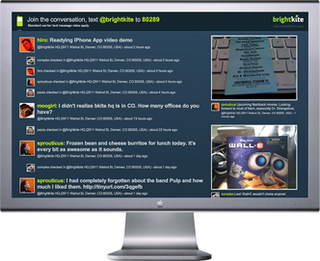In late 2008 Brightkite engaged Universal Mind to develop an application called The Brightkite Wall. The Wall is a Flash Application built using Flex.
For those of you unfamiliar with Brightkite, here’s a quick overview:
Brightkite is a location based, micro-blogging, social networking platform. Unless you’ve been living in a cave for the last five years, you’re probably familiar with sites like MySpace and Facebook. One of the features of these sites is something called a status. The status you set is meant to reflect something about your mood, or what you’re up to, i.e.. “Adam is writing a blog post”. This concept is similar to an away message on an instant messenger account. The first site to gain traction as a platform that specializes in status updates was Twitter.
Brightkite retains the idea of status updates and friending other Brightkite users, but adds the concept of a “check in”. When you “check in” in Brightkite you’re saying where you are, geographically speaking. So, status updates (called notes in Brightkite) are posted from a place. This means these notes often have an annotative quality about the place where the user is checked in. Brightkite users also have the option of posting photos at a Brightkite location. There are a lot more features in the Brightkite platform including: an iPhone application, a mobile site, and integration with other social networking platforms: Facebook, Twitter, Flickr, and Fire Eagle. To find out more about Brightkite sign up for your free account at: www.Brightkite.com.
The Brightkite Wall is a kiosk-style application that provides a feed form a place, a person, or for search terms in the Brightkite ecosystem. The application was built using Adobe’s Flex 3 Framework for building Flash Rich Internet Applications.
One development challenge we faced was to implement a user interface that scaled in size regardless of the resolution of the display it was running on. Because the Wall can be launched on any machine, those machines might have a display like a small laptop screen or up to a large projection display. The Wall user interface needed to scale appropriately for each use case. This means fonts, images, and skins all need to look, relatively, the same one any given display size. Although this feature isn’t extremely difficult technically, it is a bit tricky. However, Flex does offer some advantages when it comes to implementing a UI like the Wall.
Another challenge was implementing an application that would execute in a full screen mode and reliably for a long period of time. To achieve this requirement we implemented a “BoundedList” UI class that automatically disposes of unused list items, but also allows for various transition effects to be applied as new items appear in the lists.
The data source for the wall is the Brightkite RSS feed. The application is parameterized to allow for dynamic configuration (on launch), of the RSS feed, polling rate, Brightkite place, and the size of the bounded lists. The parameters are passed using Flash variables and accessed on the initialization of the application.
Although The Brightkite Wall is a fairly simple Flex application, built in just a few weeks, it is a great example of how Flex can fit into a platform. Many companies rely on Flex for their entire product line, and it is often a great choice for many products. In the case of Brightkite, they had a specific problem to solve and Flex happened to provide an excellent solution for the problem.
The Wall is still in beta and Brightkite needs your feedback on the kinds of features you’d like to see in the next version.
The Brightkite blog: http://blog.brightkite.com
Brightkite on Twitter: http://www.twitter.com/brightkite
